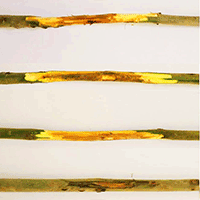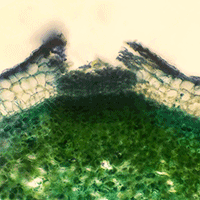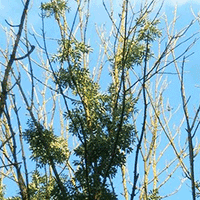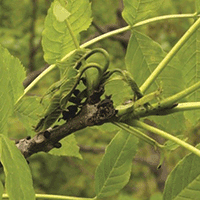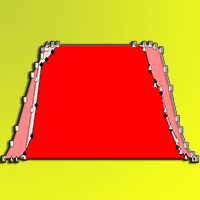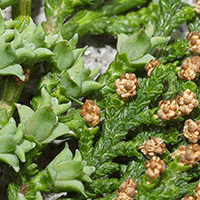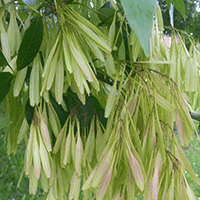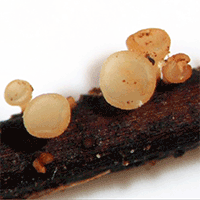
Evaluating the impact of Hymenoscyphus fraxineus in Trentino (Alps, Northern Italy): first investigations
Stefano Giongo (1), Claudia Maria Oliveira Longa (2), Elisa Dal Maso (3), Lucio Montecchio (3), Giorgio Maresi (1)
iForest - Biogeosciences and Forestry, Volume 10, Issue 6, Pages 871-878 (2017)
doi: https://doi.org/10.3832/ifor2486-010
Published: Nov 06, 2017 - Copyright © 2017 SISEF
Research Articles
Abstract
The spread of Hymenoscyphus fraxineus has been causing great concern regarding the survival of European ash (Fraxinus excelsior) throughout Europe since the 1990s. The disease was first recorded in Trentino (southern Alps, Italy) in 2012 and has spread throughout the mountain landscape, where ash trees are scattered in small and isolated stands in different valleys. The status of the disease was checked by monitoring the damage to natural regeneration and adult trees in 90 sites spread over the whole region. The survey confirmed the complete colonization by the pathogen of the whole investigated area, with high levels of damage to both young and adult ash trees. Regeneration (both seedlings and saplings) was observed to be affected by the fungus in 88 plots out of 90. Out of 4486 examined young European ashes, 2261 (50.4%) were affected and 789 (17.6%) were already dead. Ten of the 384 assayed flowering ashes (Fraxinus ornus) showed symptoms on branches and apical stems, similar to those observed for European ash. Isolation and molecular analysis proved the presence of the fungus on both symptomatic European and flowering ashes. The examined 386 adult trees showed different levels of damage, sometimes reaching more than 75% of the crown. Some individual trees (42) growing close to severely damaged trees appeared fully healthy, which suggests the possible existence of some resistant/tolerant individuals in the examined populations.
Keywords
Ash Dieback, Fraxinus excelsior, Fraxinus ornus, Natural Regeneration, Forest Management
Authors’ Info
Authors’ address
Giorgio Maresi
Fondazione Edmund Mach, Centre for Technology Transfer, v. E. Mach 1, 38010 San Michele all’Adige, TN (Italy)
Fondazione Edmund Mach, Research and Innovation Centre, Department of Sustainable Agroecosystems and Bioresources, San Michele all’Adige, TN (Italy)
Lucio Montecchio
University of Padova, Department of Land, Environment, Agriculture and Forestry, v.le dell’Università 16, 35020 Legnaro, PD (Italy)
Corresponding author
Paper Info
Citation
Giongo S, Oliveira Longa CM, Dal Maso E, Montecchio L, Maresi G (2017). Evaluating the impact of Hymenoscyphus fraxineus in Trentino (Alps, Northern Italy): first investigations. iForest 10: 871-878. - doi: 10.3832/ifor2486-010
Academic Editor
Alberto Santini
Paper history
Received: May 08, 2017
Accepted: Sep 20, 2017
First online: Nov 06, 2017
Publication Date: Dec 31, 2017
Publication Time: 1.57 months
Copyright Information
© SISEF - The Italian Society of Silviculture and Forest Ecology 2017
Open Access
This article is distributed under the terms of the Creative Commons Attribution-Non Commercial 4.0 International (https://creativecommons.org/licenses/by-nc/4.0/), which permits unrestricted use, distribution, and reproduction in any medium, provided you give appropriate credit to the original author(s) and the source, provide a link to the Creative Commons license, and indicate if changes were made.
Web Metrics
Breakdown by View Type
Article Usage
Total Article Views: 48610
(from publication date up to now)
Breakdown by View Type
HTML Page Views: 40267
Abstract Page Views: 3153
PDF Downloads: 3816
Citation/Reference Downloads: 20
XML Downloads: 1354
Web Metrics
Days since publication: 2982
Overall contacts: 48610
Avg. contacts per week: 114.11
Citation Metrics
Article Citations
Article citations are based on data periodically collected from the Clarivate Web of Science web site
(last update: Mar 2025)
Total number of cites (since 2017): 11
Average cites per year: 1.22
Publication Metrics
by Dimensions ©
Articles citing this article
List of the papers citing this article based on CrossRef Cited-by.
References
BAUSINVE 2015: Inventario fitopatologico forestale regionale Stato fitosanitario delle foreste del Friuli Venezia Giulia [Forest phytopatological inventory, Forest health status in Friuli Venezia Giulia]. Notiziario ERSA 1-2016, Udine, Italy, pp. 8. [in Italian]
Gscholar
BAUSINVE 2016: Inventario fitopatologico forestale regionale Stato fitosanitario delle foreste del Friuli Venezia Giulia [Forest phytopatological inventory, Forest health status in Friuli Venezia Giulia]. Notiziario ERSA 1-2017, Udine, Italy, pp. 8. [in Italian]
Gscholar
Ash dieback in Germany: research on disease development, resistance and management options. In: “Dieback of European Ash (Fraxinus spp.): Consequences and Guidelines for Sustainable Management” (Vasaitis R, Enderle R eds). Swedish University of Agricultural Sciences, Uppsala, Sweden, pp. 89-105.
Online | Gscholar
Il deperimento del frassino [Ash Dieback]. Terra Trentina 58 (4): 54. [in Italian]
Gscholar
L’Inventario Nazionale delle Foreste e dei serbatoi forestali di Carbonio INFC 2005. Secondo inventario forestale nazionale italiano. Metodi e risultati [Forest and carbon sink National inventory INFC 2005. Second Italian National Forest inventory]. MIPAAF, CFS, CRA, Edagricole-Il Sole 24 ore, Bologna, Italy, pp. 653. [in Italian]
Gscholar
From the Alps to the Apennines: possible spread of ash dieback in Mediterranean areas. In: “Dieback of European Ash (Fraxinus spp.): Consequences and Guidelines for Sustainable Management” (Vasaitis R, Enderle R eds). Swedish University of Agricultural Sciences, Uppsala, Sweden, pp. 140-149.
Gscholar
The ash dieback pathogen Hymenoscyphus pseudoalbidus is associated with leaf symptoms on ash species (Fraxinus spp.). Journal of Agricultural Extension and Rural Development 4: 261-265.
Gscholar
Changes of young ash stands area in Latvia and invasion of Hymenoscyphus fraxineus. Proceedings of the Latvian Academy of Sciences, Section B 70 (3): 124-130.
Gscholar
Situation with ash in Italy: stand characteristics, health condition, ongoing work and research needs. In: Interim Report from the Meeting “Chalara fraxinea, FRAXBACK” (Mainprize N, Hendry S, Weir J eds). Vilnius (Lithuania) 13-14 Nov 2012. Forestry Commission, Bristol, UK, pp. 25-26.
Gscholar
Il deperimento del frassino maggiore nel Trentino: diffusione dei danni durante l’estate 2014 [European ash dieback in Trentino: damages spread during 2014 summer]. Dendronatura 35 (2): 62-70. [in Italian]
Gscholar
Sanasilva - Le chiome degli alberi [Tree crowns]. Swiss Institute for Forest, Snow and Landscape Research, Birmensdorf, Switzerland, pp. 129. [in Italian]
Gscholar
Sterben ausgewachsene Eschen auch ab? [Do the adult ash trees dìe too?]. Wald und Holz 6: 23-26. [in German]
Gscholar
Le dépérissement des pousses du frêne. Biologie, symptômes et recommandations pour la gestion [The dieback of ash shoots. Biology, symptoms and management recommendations]. Notice pour le praticien 57, WSL, Birmensdorf, Switzerland, pp. 8. [in French]
Online | Gscholar
Il monitoraggio fitosanitario delle foreste trentine: risultati e prospettive dopo oltre 20 anni di applicazione [Forest health monitoring in Trentino: results and perspectives after 20 years]. In: Proceedings of the “IX Congresso Nazionale SISEF - Multifunzionalità degli ecosistemi forestali montani: sfide e opportunità per la ricerca e lo sviluppo”. Bolzano (Italy), 16-19 Sept 2013, pp. 80. [in Italian]
Online | Gscholar
Ecologia e gestione dei boschi di neoformazione nel paesaggio del Trentino [Ecology and management of neo formation wood in Trentino landscape]. Servizio Foreste e Fauna, Provincia di Trento, Trento, Italy, pp. 301. [in Italian]
Gscholar
I frassineti: un’occasione da non perdere [Ash stands: an occasion not to be lost]. Terra Trentina 51 (7): 37-39. [in Italian]
Gscholar

